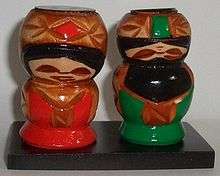Koro-pok-guru
Koro-pok-guru (コロポックル Koropokkuru), also written Koro-pok-kuru, korobokkuru, or koropokkur, are a race of small people in folklore of the Ainu people of the northern Japanese islands. The name is traditionally analysed as a tripartite compound of kor or koro ("butterbur plant"), pok ("under, below"), and kur or kuru ("person") and interpreted to mean "people below the leaves of the butterbur plant" in the Ainu language.
The Ainu believe that the koro-pok-guru were the people who lived in the Ainu's land before the Ainu themselves lived there. They were short of stature, agile, and skilled at fishing. They lived in pits with roofs made from butterbur leaves.
Long ago, the koro-pok-guru were on good terms with the Ainu, and would send them deer, fish, and other game and exchange goods with them. The little people hated to be seen, however, so they would stealthily make their deliveries under cover of night.
One day, a young Ainu man decided he wanted to see a koro-pok-guru for himself, so he waited in ambush by the window where their gifts were usually left. When a koro-pok-guru came to place something there, the young man grabbed it by the hand and dragged it inside. It turned out to be a beautiful koro-pok-guru woman, who was so enraged at the young man's rudeness that her people have not been seen since. Their pits, pottery, and stone implements, the Ainu believe, still remain scattered about the landscape.
In popular culture

- In the manga Shaman King the koropokkur ("minutians" in the English version) are depicted as a race of tiny spirit creatures which are influential to the background of the teenage Ainu shaman Horohoro. A particular koropokkur—named Kororo (Corey, in English)—accompanies Horohoro as his guardian spirit.
- They appear as playable race Koborokuru in Shadowrun, in the Shadowrun Companion: Beyond the Shadows rulebook.[1]
- The "Corobockles" of Squaresoft's action-adventure game Seiken Densetsu III may be related to Japanese Koropokkuru.
- "Koropokkuru" 「コロポックル」 is also the Official Fan Club name of the Japanese band Kra.
- In the video game The Legend of Zelda: The Minish Cap, tiny creatures called Picori (ピッコル Pikkoru) dwell in houses under plant leaves and hide items in tall grass and pots for the player to find, such as money or arrows.
- In the video game Ōkami, one of the main protagonists is Issun (Issun-bōshi), an inch-tall boy from the village of Ponc'tan, which is the home of a tiny race of beings known in the English variant as Poncles (Koro-pok-guru). Ponc'tan resides in the Yoshpet forest (Aokigahara), which is within the lands of Kamui. Kamui is in northern Nippon, and is inhabited by a race of humans with shapeshifting abilities, known as the Oina (Ainu) Tribe.
- In the anime Inu x Boku one of the maids (Kotomura Chino) is a Koro-pok-guru
- In the manga and anime Honey and Clover, Hagu is used by Morita as "evidence" of the Koro-pok-guru for a website to get money.
- In the video game Dark Cloud and Dark Chronicle there are enemies in the Japanese versions called "Pokokku" which are named after the seven weekdays and are found in the Wise Owl Forest, and have a variant in Moon Sea. In Dark Chronicle they return for Starlight Canyon and are called "Laughing Pokkuru" and have variants throughout the game. The English version of Dark Cloud mistranslated them to "Pockle" and mistranslated them to "Smiling Fairy" in Dark Chronicle.
- In Food Wars!: Shokugeki no Soma, the character Megumi Tadokoro is compared to a koro-pok-guru by Donato Gotouda for serving a terrine that showcases Tohoku-style preserved vegetables.
- In Advanced Dungeons & Dragons Oriental Adventures, the "korobokuru" are depicted as small, hairy dwarves who are less sophisticated than humans, rude, and pugnacious, but strong and tough.
- The video game Starbound previously held a contest for users to design a hat, with one of the winners being the "Corobockle", a small humanoid creature sitting atop the player's head, by user Bietol.
See also
Further reading
- John Batchelor (1904). The Koropok-Guru or pit-dwellers of north Japan, and, A critical examination of the nomenclature of Yezo, Volume 19. YOKOHAMA: Japan Mail. p. 18. Retrieved 1 March 2012.(Harvard University)(Digitized Jan 20, 2006)
- Arnold Henry Savage Landor (2001). Alone with the Hairy Ainu or, 3,800 Miles on a Pack Saddle in Yezo and a Cruise to the Kurile Islands. Elibron. ISBN 9781402172656.
References
External links
- – Ainu Entry from the 1911 Encyclopædia Britannica which includes a somewhat different interpretation of the koro-pok-guru.
